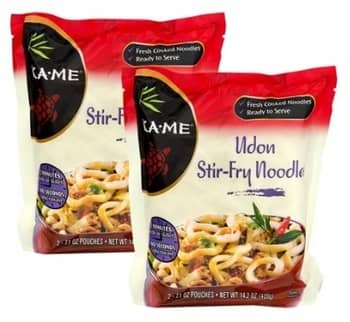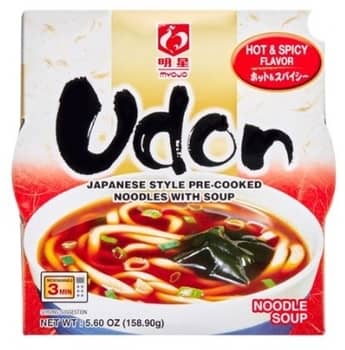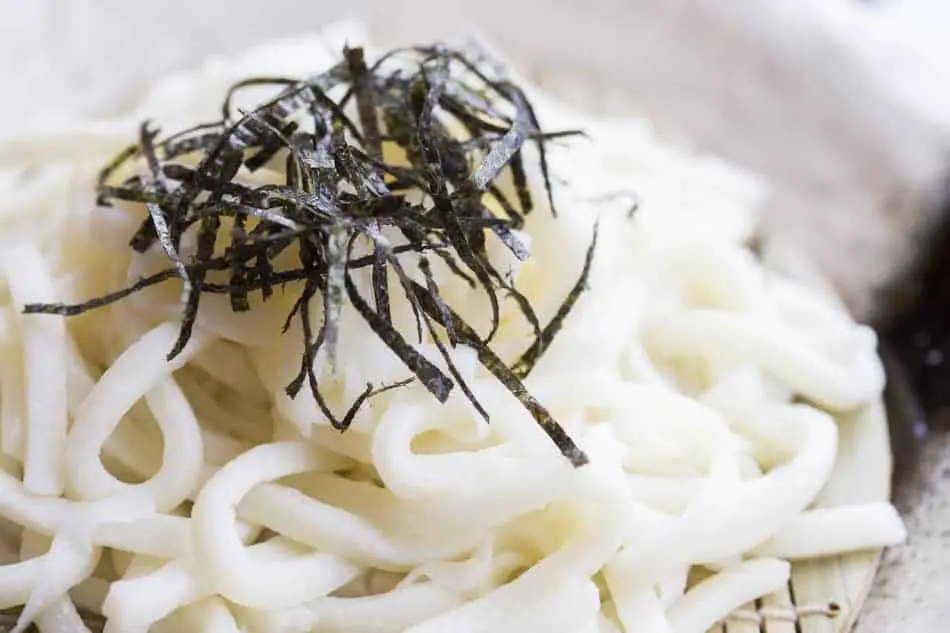Udon is a thick variety of noodles frequently used in Japanese cuisine. It’s also commonly used in Korean and Palauan dishes.1
In its simplest form, it’s served hot as a noodle soup, but can also be served alongside numerous dishes, both vegan and non-vegan. We’ll be covering the vegan status of udon itself as well as its numerous manifestations.
Is it vegan? Yes, udon noodles tend to be vegan. Though they’re referred to as noodles (i.e. not simply “pasta”), udon is one of the few types of noodles that don’t contain egg. They contain wheat flour and water.
What we’ll do here is go over the various reasons udon noodles are generally considered vegan, and any udon noodles on the market that are known to be vegan-friendly. We’ll also touch on common non-vegan dishes that tend to contain animal products.
Why Udon Noodles Are Generally Vegan
It basically comes down to the fact that udon noodles don’t contain eggs. Which is counterintuitive, because the presence of egg is what sets noodles (a specific type of pasta) apart from pasta in general
In its most basic form, pasta, aka “alimentary paste,” is made by combining semolina flour and/or farina with water—though other types of wheat can be used.
When eggs are added at 5.5% or more egg by weight, the pasta product is then referred to as noodles.2
For some odd reason, there are eggless varieties of pasta on the market that are still referred to as noodles (despite being eggless), among which Asian noodles like udon are included.2
I suppose just to confuse us.
Asian noodles are typically made from wheat flours other than farina or semolina (the standard wheat flour used in pasta) and they are often clear or translucent in appearance.3
Because they rarely contain eggs, udon noodles are often referred to as imitation noodles in the West.2
Don’t get me wrong, egg is always a possible ingredient in processed foods, and udon noodles are no exception. So, you’ll always want to check the food label to be sure. But, the default formulation for udon noodles doesn’t call for eggs.
Eggs are used in food products for a variety of reasons. For example, egg proteins make for a good binder in bakery products. The proteins mix throughout doughs and batters binding the various ingredients together.
In pasta, it’s a bit different, because the wheat flour usually provides enough gluten to serve as a binder.
Instead, noodles make use of eggs for reasons of color and texture.
The yellow color characteristic of certain noodles is often derived from egg yolks, though carotenoids (plant-based vitamin A) can be used.2
The texture of noodles or “egg pasta” is a bit stronger compared to plain pasta and the mouth-feel is quite different.4
The use of eggs also changes the nutritional profile of the pasta, which can result in price differences.4
Fortunately for vegans, manufacturers of Asian noodles tend not to value the yellow color or stronger texture.
Non-Vegan Udon Preparations
First, there’s the broth to consider. Udon noodle soup is made with a broth that can include both plant-based and animal-derived ingredients. For example, kake udon is served in a broth called kakejiru, which is made of soy sauce, mirin (rice wine), and dashi.1,5
The latter (dashi) is usually made with fish stock.6
Like the broth, toppings for udon soup can be both animal and plant-based. Plant-based ingredients can include chopped scallions and aburaage, which is a type of deep-fried tofu pocket seasoned with mirin, sugar, and soy sauce.
Common animal ingredients include seafood tempura, often kakiage or prawn. A type of half-moon fish cake called kamaboko is often added.
For example, Nongshim Fresh Udon Bowls contain:7
- Wheat Flour, Tapioca Starch
- Water, Salt, Sugar
- Wheat Gluten
- Dextrin, Dextrose, Corn Syrup
- Soy Sauce (Soy, Wheat, Salt)
- Rice Bran Oil
- Acetic Acid
- Anchovy (Extracted)
- Bonito (Extracted)
- Disodium Guanylate, Disodium Inosinate, D-Sorbitol
- Dried Fish Cake (D-Sorbitol, Potato Starch, Pollock, Polyglycerol Esters of Fatty Acids, Paprika Color)
- Dried Vegetable Flakes (Green Onion, Seaweed, Red Chili Pepper)
- Hydrolyzed Soy Protein
- Lecithin (Soy)
- Mushroom (Extracted)
- Natural Flavors
- Non-Dairy Lactic Acid, Potassium Carbonate
- Radish (Extracted), Red Chili Pepper Powder, Seaweed (Extracted)
- Tempura Flakes (Wheat Flour, Palm Oil, Onion, Bonito, Cuttlefish)
- Tuna (Extracted)
- Yeast Extract.
These are just a few examples to give you an idea. Just know that if you see udon on the menu when eating out, you’ll definitely want to vet the ingredients—either by asking the restaurant staff or checking the website.
Commercial Vegan Udon Noodles
Now that we know that udon noodles tend to be vegan, we’ll cover a few products that are known to be free of animal ingredients.
KA-ME Udon Stir Fry Noodles

This version is just the noodles (no recipe), so we’re much safer here.
These simply contain water, wheat flour, salt, tapioca flour, and lactic acid.8
Lactic acid (LA) can be animal-derived, but it tends to be made via LA-producing bacteria fed on a diet of glucose from starch, pure sucrose, raw sugar, and beet juice.9,10
Myojo Udon Soup: Hot & Spicy Flavor

Ingredients include:11
- Enriched Wheat Flour (Flour, Niacin, Thiamine Mononitrate, Riboflavin, Folic Acid)
- Water, Salt, Lactic Acid
- Tapioca Starch
- Propylene Glycol Alginate
- Sodium Benzoate (to Retard Spoilage)
- Natural Flavor
That’s it for the vegan status of udon noodles. Thanks for reading.
You may also want to check out the following related articles:
References
- Udon. https://en.wikipedia.org/wiki/Udon
- Understanding Food: Principles and Preparation (Page 359). Amy Brown – Wadsworth Cengage Learning – 2011. ISBN-10: 0-538-73498-1
- Chansri R, C Puttanlek, V Rungsadthong, and D Uttapap. Characteristics of clear noodles prepared from edible canna starches. Journal of Food Science 70(5):S337– S342, 2005.
- Pasta and Semolina Technology (Page 177). R. Kill-Keith Turnbull – Blackwell Science – 2001. ISBN 0-632-05349-6.
- Dashi. https://en.wikipedia.org/wiki/Dashi
- Mirin. https://en.wikipedia.org/wiki/Mirin
- Nongshim Fresh Udon Bowl, 9.73 Oz, 6 C. https://www.walmart.com/ip/Nongshim-Fresh-Udon-Bowl-9-73-Oz-6-Ct/37204316
- KA-ME Udon Stir Fry Noodles. https://kame.com/udon-stir-fry-noodles/
- Lactic Acid. https://en.wikipedia.org/wiki/Lactic_acid
- Groot W, van Krieken J, Slekersl O, de Vos S (19 October 2010). “Chemistry and production of lactic acid, lactide and poly(lactic acid)”. In Auras R, Lim L, Selke SE, Tsuji H (eds.). Poly(Lactic acid). Hoboken: Wiley. p. 3. ISBN 978-0-470-29366-9.
- Myojo Udon Soup Hot & Spicy Flavor. https://www.heb.com/product-detail/myojo-udon-soup-hot-spicy-flavor/2034223

